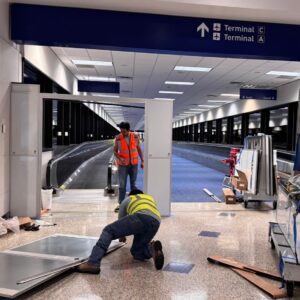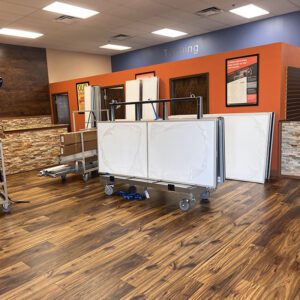Modular Containment Solutions for Airports
With millions of passengers passing through their terminals each day, ensuring safety, efficiency, and comfort within airports is a must. Managing security, constant renovations, and crowd control issues are significant hurdles most airline authorities must overcome daily.
However, in recent years, solutions utilizing modular temporary walls have emerged as a game-changer, offering a versatile approach to address these airport challenges effectively. In this blog post, we delve into the benefits and applications of modular containment solutions for airports, exploring how they enhance security, streamline renovations, and optimize crowd control.
Benefits of Modular Walls for Airports:
Modular Walls for Security
Security stands as a cornerstone of airport operations, with stringent measures in place to safeguard passengers, staff, and infrastructure. Modular walls offer a flexible solution for creating secure zones within airport facilities.
These walls can be swiftly deployed to establish temporary barriers, containment areas, or security checkpoints as needed. Their customizable design allows for integration with access control systems, surveillance equipment, and other security features, ensuring robust protection against potential threats.
Using Modular Walls for Airport Crowd Control
Airports often experience fluctuations in passenger flow, particularly during peak travel seasons or in response to unforeseen events. Modular walls provide a dynamic tool for managing crowd movement and density within terminal spaces. By strategically configuring barriers and partitions, airport authorities can optimize traffic flow, minimize congestion, and enhance the overall passenger experience. Additionally, modular walls can be equipped with signage and wayfinding elements to guide travelers efficiently through complex environments.
Using Modular Walls for Security Screening:
Incorporating modular walls into security screening processes enhances efficiency and effectiveness. These walls can create designated areas for passenger screening, baggage checks, and other security procedures, optimizing flow and ensuring thorough inspections while minimizing disruptions to the overall airport operations.
Ease of Installation and Removal
One of the key advantages of modular containment solutions is their ease of installation and removal. Unlike traditional construction methods that entail prolonged disruptions and extensive labor, modular walls can be quickly assembled, reconfigured, or dismantled with minimal impact on airport operations. This flexibility allows airport authorities to adapt to evolving needs, whether for temporary security measures, short-term renovations, or event-specific crowd management initiatives.
How Modular Walls Help Airport Renovations
Modular walls are most often used during occupied renovations. These walls allow companies to keep operations flowing and give customers a pleasant experience. Below are ways that modular walls can help airports during renovations.
- Noise Reduction: During renovation projects, noise control is essential to mitigate disruptions and maintain a comfortable environment for passengers. Modular walls equipped with soundproofing materials help contain construction-related noise, minimizing its impact on terminal activities.
- Security: Renovations may involve sensitive areas or infrastructure that require enhanced security measures. Temporary Wall Systems’ walls can be modified with secure locks and keypads for construction zones, preventing unauthorized access and safeguarding valuable assets.
- Dust Mitigation: Dust generated during renovations can pose a significant challenge, particularly when air quality is critical. Modular containment solutions can be fitted with standard MERV filters or have built-in HEPA filtration systems to capture airborne particles, maintaining clean and breathable air within the terminal space.
Conclusion
In conclusion, modular containment solutions offer a multifaceted approach to address the diverse challenges faced by airports, ranging from security enhancements and renovations to crowd control measures. By leveraging the benefits of modular walls, airport authorities can optimize operational efficiency, improve passenger experience, and uphold the highest standards of safety and security within these critical transportation hubs. As airports continue to evolve and adapt to meet the demands of modern travel, modular containment solutions stand poised to play an increasingly integral role in shaping the future of aviation infrastructure worldwide.


